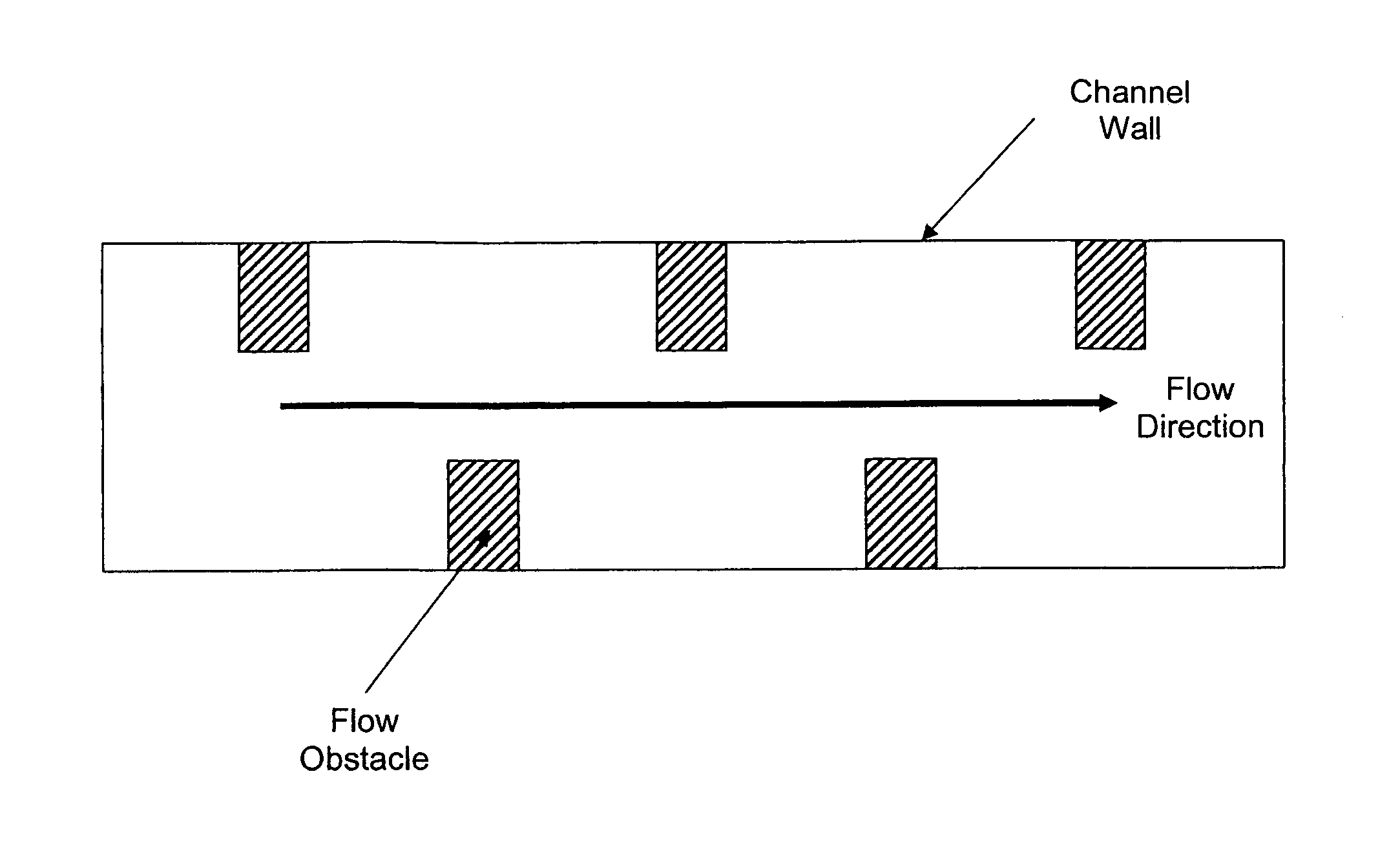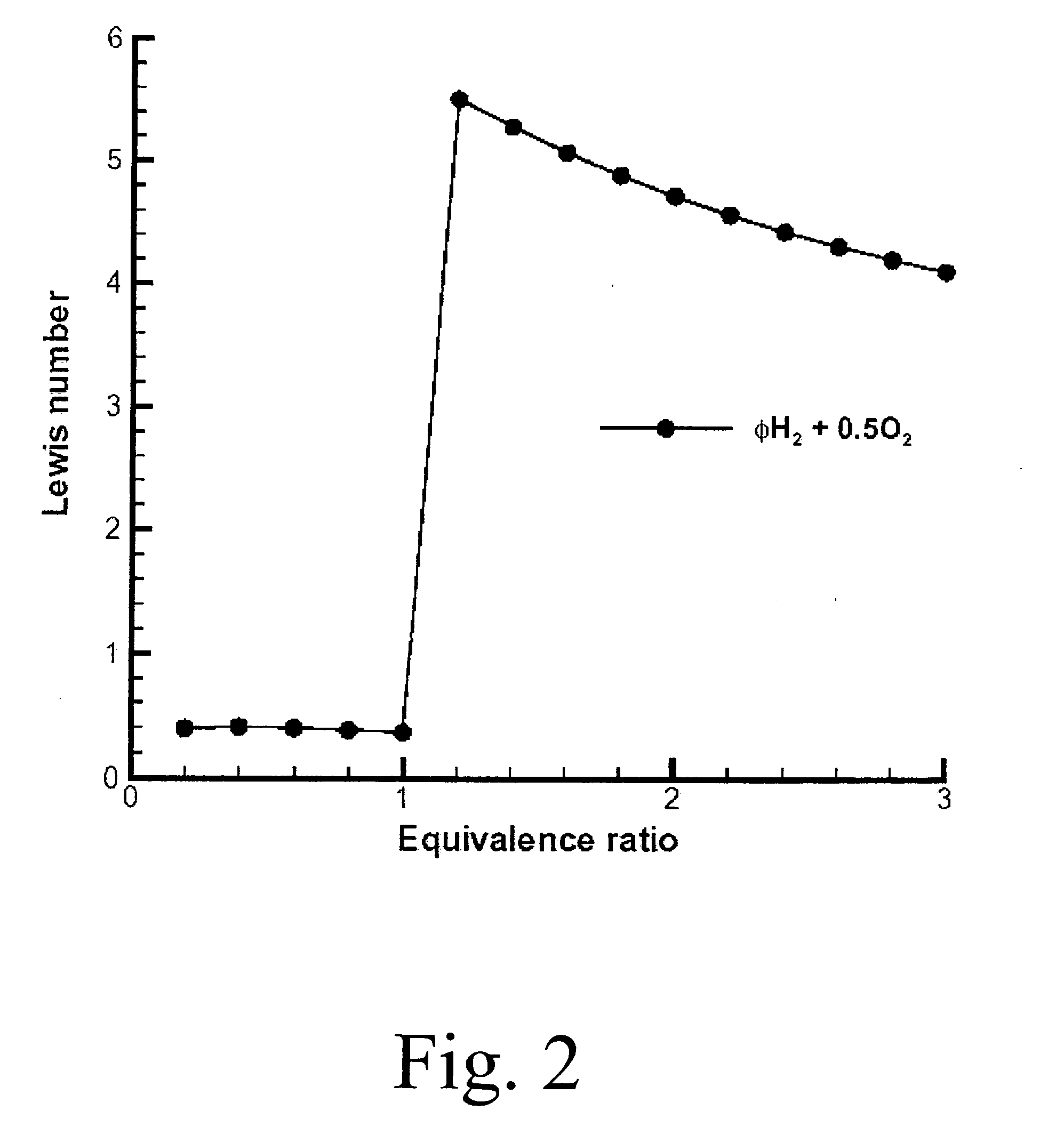Detonation safety in microchannels
a microchannel and microchannel technology, applied in the field of conductive oxidation, can solve problems such as difficult general context quantification, and achieve the effect of accelerating the rapid reaction of the gas mixtur
- Summary
- Abstract
- Description
- Claims
- Application Information
AI Technical Summary
Benefits of technology
Problems solved by technology
Method used
Image
Examples
example 1
Determine the Combustion Regime of a Hydrogen / Oxygen Mixture
[0057] The equivalence ratio is defined as ϕ=(F / O)(F / O)st
where [0058] (F / O)=the fuel-to-air mass ratio present in the system (dimensionless) [0059] (F / O)st=the stoichiometric fuel-to-air mass ratio (dimensionless)
The oxidation of hydrogen under stoichiometric conditions is given by the balanced equation H2+12O2->H2OTherefore (F / O)st=1 gmole H2×2.016 g H2 / gmole H21 gmole O2×32 g O2 / gmole O2≈18=0.125
Suppose we have a fuel rich mixture with a fuel-oxidant ratio (F / O)=0.2. Then the equivalence ratio φ=0.2 / 0.125=1.6. Using FIG. 2, the Lewis number evaluates to approximately 5. On the other hand, using FIG. 3, the Zeldovich number β is approximately 3. Therefore β(Le−1)=12>−2 which implies stable flame propagation and therefore we should use the expansion ratio criteria that σ>3.5 is required for possible detonation. Using FIG. 4 at an equivalence ratio of 1.6, we see that σ≈8 which far exc...
example 2
Calculation of Hydrogen / Oxygen Maximum Allowable Channel Gap
[0087] The above correlation was used to compute the predicted detonation cell size as a function of dry hydrogen concentration and steam concentration for various initial temperatures. The results of the cell size predictions and their comparison to experimental data is given in Table 3A.
TABLE 3AComparison of Predicted to Experimentally MeasuredDetonation Cell Size for a H2 / O2 / H2O System.PredictedMeasuredDry HydrogenSteamInitialDetonationDetonationConcentration,Concentration,InitialPressure,Cell Size,Cell Size,Vol %Vol %Temperature, KMPacmcm30103750.11.671.5730105000.11.251.1130106500.11.040.9530203750.12.933.1630205000.12.012.1230206500.11.581.3530303750.15.305.4730305000.13.344.0630306500.12.502.23
Note:
Experimental data was taken from FIG. D.2-2 in Appendix D of the OECD study (Flame Acceleration and Deflagration to Detonation Transition in Nuclear Safety (State-of-the-Art Report by a Group of Experts), OECD Nuclear ...
example 3
Determination of Maximum Allowable Channel Gap at a Sudden Expansion for a Rectangular Channel
[0093] Suppose a microchannel design that has a channel with a rectangular cross-section and a channel height-to-width ratio of 0.1 requires a macro-to-micro (M2M) interface that will incorporate a sudden expansion. The detonation cell size has been determined under worst-case conditions and has been determined to be some value, say λ*=1.5 mm. The designer wishes to exceed this channel gap by appropriately limiting the length to less than the detonation run-up distance L* (see Example 4). What is the maximum gap size allowable for the micro-to-macro manifold that will not permit DDT at the expansion? Referring to Table 4, an expansion connected to a rectangular channel with a low aspect ratio or alternatively low height-to-width ratio of 0.2 or less is limited to 3λ in gap size where λ denotes the detonation cell size. Therefore, the channel gap in this case must not exceed 3λ* or 4.5 mm i...
PUM
 Login to View More
Login to View More Abstract
Description
Claims
Application Information
 Login to View More
Login to View More - R&D
- Intellectual Property
- Life Sciences
- Materials
- Tech Scout
- Unparalleled Data Quality
- Higher Quality Content
- 60% Fewer Hallucinations
Browse by: Latest US Patents, China's latest patents, Technical Efficacy Thesaurus, Application Domain, Technology Topic, Popular Technical Reports.
© 2025 PatSnap. All rights reserved.Legal|Privacy policy|Modern Slavery Act Transparency Statement|Sitemap|About US| Contact US: help@patsnap.com



